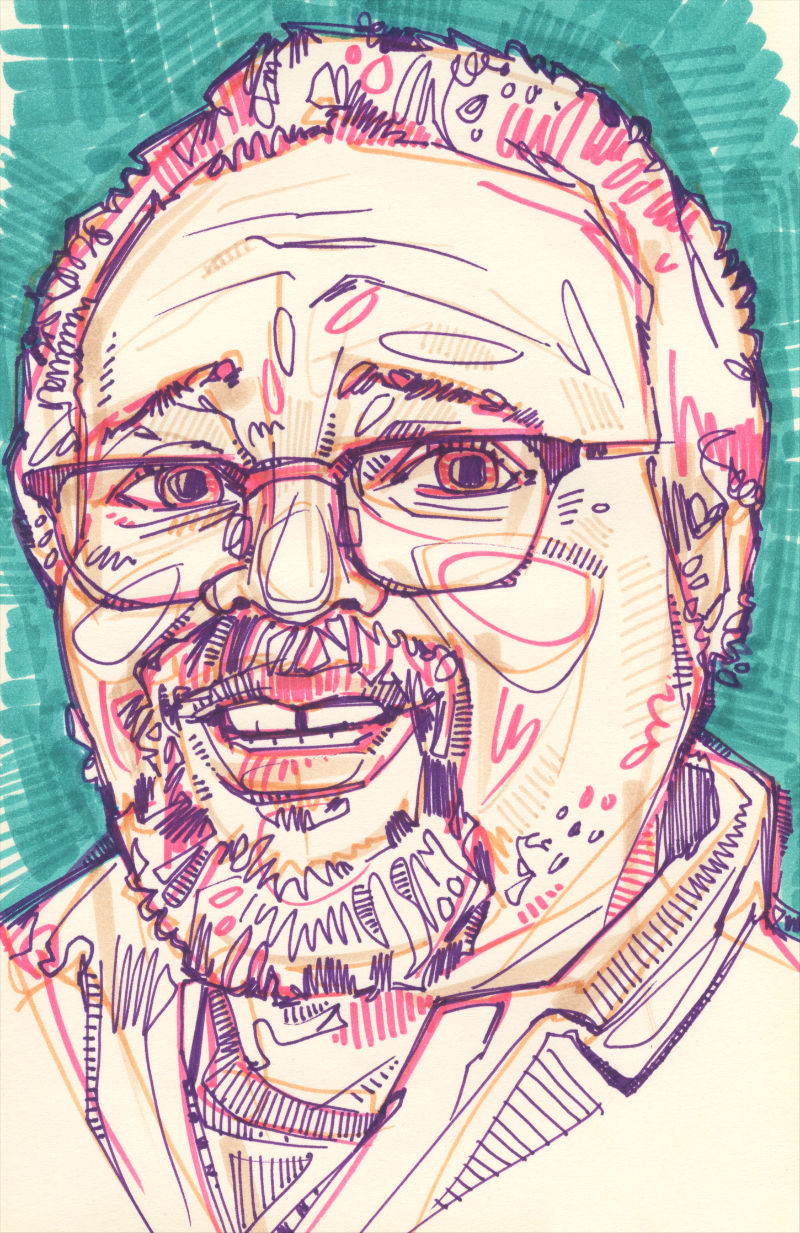Blog / 2019 / Job with Justice Travel Log, Part 2
March 28, 2019
I’m contributing to a book about collective bargaining and how it can be used by more than just labor unions. Since I’ll be painting portraits of the workers whose stories are featured in the book, I’ve been doing a lot of traveling to meet these workers and photograph them. What follows are some of my notes from my travels.
Jackson, Mississippi
March 1
We arrived at the NAACP State Conference Office without quite understanding what we were getting into. Sanchioni, the retired autoworker we were interviewing, had arranged to meet us there and had also set up a tour of the building with historian Frank Figgers.

Frank
2019
marker on paper
8 x 5 inches
The NAACP offices are located in the MW Stringer Grand Lodge, and Frank explained how the Prince Hall Freemasons in Mississippi have supported the NAACP for a long time. Then he showed us Medgar Evers’ offices, including the bullet holes that are still in the windows.
The holes communicated on a visceral level just how dangerous the fight against racism is, and the choice to preserve the windows with the holes highlights that this building is a living, breathing monument to a community that stands for justice. The Grand Lodge and NAACP offices are sacred both in that they are a place where important historical moments occurred and also in their current role as a space for people to gather and organize.
And Sanchioni described just that, telling us of recent actions that had been designed in the meeting room where we interviewed her. I connected with her especially in her preference for plain words. She objected to the way outside organizers are sometimes “parachuted in” to communities, waving around their fancy vocabulary and their ignorance of how things work on the local level.
It’s obviously a different situation, but it reminds me of how institutional artists often use artspeak instead of plain words in their artist statements and press releases. Sometimes these creatives are intentionally excluding people with their technical terms and specialized phrases, but mostly I think that artspeak reveals a lack a self-awareness or a deep insecurity. People who complicate their language unnecessarily are either too busy expressing themselves to actually communicate, or they are filling some kind of hole in their hearts by showing off.
And I’ve been there—sometimes I’m still there!—but every day I work at being aware of others and how I occur for them. Sanchioni helped me remember just how important that self-work is.
St. Louis, Missouri
March 2
We met up with Bettie, a fast food restaurant employee. More than any of the other workers we encountered, Bettie was thrilled to hear she was going to have her portrait painted. And after seeing some samples of my art, her enthusiasm ballooned: she described in detail where in her house she would hang an enormous print of the piece!
Her response endeared me to her immediately and also made me curious about where it was coming from. Some of it has to be Bettie’s innate positivity, but I think it might also have to do with her siblings. One of her brothers is a musician, one of her sisters is a visual artist, and all of them were brought up with art as a part of their everyday. In other words, it’s amazing how exposure to art can bring joy in so many ways—even preparing you for the day when someone will ask to paint your portrait in order to honor the work you do to make economic justice a reality!
Bettie talked very openly about her financial struggles, and this was both painful and powerful. While I’m sure that not everyone adores her on sight, Bettie does have an undeniable charisma, making her advocacy on behalf of minimum wage workers very effective.
It also made me reflect on all the money being used to make this book happen. I mean, I get that you have to spend money to make money—I wouldn’t have an art career if I didn’t reinvest everything I make into my art—but all the travel expenses have been jarring for me. They emphasize, yet again, just how simply my partner and I live.
This situation also made me see that I never ask for enough money for the work I do, because I always assume that others are struggling too, even if I’m pretty sure they are making much more money than I am. In other words, I pretend to understand that art is not a luxury, but clearly not all of me believes it—not fully. Bettie’s advocacy along with her interest in my art re-centered me when I didn’t even know how badly I needed that re-centering. I am so pleased to be painting her!
UPDATE
March 10, 2022
You can see all the paintings from this project here, and the book, The Future We Need, is now available!
For more information about this project and to see images of the works in progress, check out these posts:
- Job with Justice Travel Log, Part 1
- Job with Justice Travel Log, Part 3
- Job with Justice Travel Log, Part 4
- Job with Justice Travel Log, Part 5
- Why Artists Should Be Paid Every Time They Exhibit
- My Non-artist Résumé
- Tips for Painting Portraits from Other People’s Photos
- The 2 Kinds of Art Patron
- Painting a Black Person’s Portrait Versus Painting a White Person’s
- How Art Lovers Can Help Fix Art World Inequalities
- A New Kind of Series
- Your Worth Is Not Determined by How Much Money You Make
- The Future We Need
- Art That Saves the World
- New York City Art and My 19th Artiversary
Maybe this post made you think of something you want to share with me? Or perhaps you have a question about my art? I’d love to hear from you!
To receive an email every time I publish a new article or video, sign up for my special mailing list.
If you enjoyed this post, Ko-fi allows you to donate. Every dollar you give is worth a bajillion to me!



